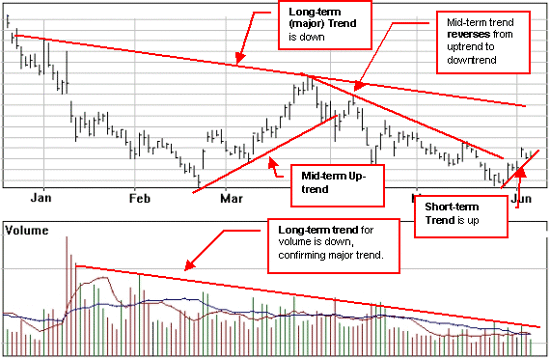Dow Theory
Dow Theory At a Glance
Overview
Dow Theory is based on the philosophy that the market prices
reflect every significant factor that affects supply and demand - volume of
trade, fluctuations in exchange rates, commodity prices, bank rates, and so
on. In other words, the daily closing price reflects the psychology of all
players involved in a particular marketplace - or the combined judgment of all
market participants.
The goal of the theory is to determine changes in
the major trends or movements of the market. Markets tend to move in the
direction of a trend once it becomes established, until it demonstrates a
reversal. Dow theory is interested in the direction of a trend and doesn't offer
any forecasting ability for determining the ultimate duration of a trend.
Much of today's technical analysis is based on
Dow's original "trend following' system -
- Classification of a trend
- Principles of confirmation or divergence
- Use of volume to confirm trends
- Use of percentage retracement
- Recognition of major bull and bear markets
- Signaling the large central section of important market
moves
- Dow theory has been successful in identifying 68% the
major trends over the years
The three trends are:
- Uptrend: successively higher peaks (highs) and higher
troughs (lows)
- Downtrend: successively lower peaks and troughs
- Sideways Channel: peaks and troughs don't successively
rise or fall
Each market trend has three parts compared to
tides, waves and ripples.
- The primary (major) trend or tide is a long term trend
lasting from a year to several years
- The secondary trend (or mid-term trend) or wave lasts
three weeks to three months and represents corrections of one third to two
thirds of the previous movement - most often fifty percent of the movement.
- The minor trends (short-term trends) or insignificant
ripples last less than three weeks and represent fluctuations in the
secondary trend.
The major trend has three phases:
- Accumulation phase: knowledgeable investors buy issues
with good potential
- Public Participation phase: Prices increasing rapidly and
bullish markets are reported
- Distribution phase: Astute investors sell first, thereby
leading the public
A Major or Long-term Stock Market Trend:
- Must be confirmed by the Dow Averages, calculated on
closing prices only, not the daily high or low (this provides the overall
stock market trend)
- Should have volume increase/decrease in the direction of
the trend
- Stays in effect until it gives definite reversal signals
Shortcomings of the Dow Theory:
- The major criticism of the Dow Theory is its slowness: It
misses about 25% of a move before giving a signal, primarily because it is a
trend following system designed to identify existing trends.
Also see trendlines,
tops & bottoms,
and triangles.
